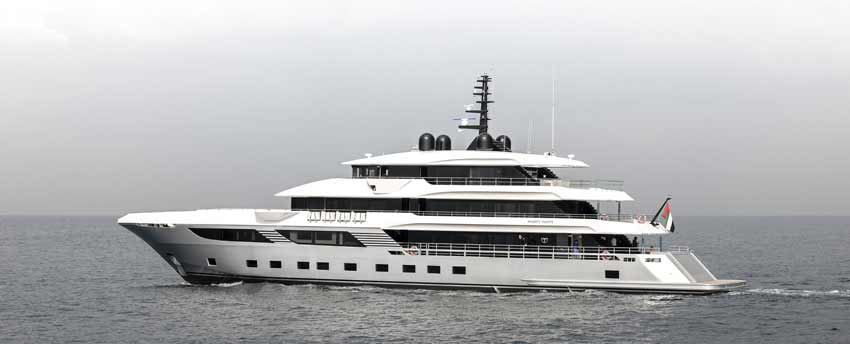Gulf Craft is on a mission to promote the UAE as a capable rival to the Netherlands, Turkey, the UK and the US when it comes to producing high-quality superyachts and megayachts. Set to celebrate its 40th anniversary next year, the builder specialises in boats sized roughly 9-54m in length, and estimates that it is has a manufacturing capacity of 200 vessels yearly, including fishing vessels, recreational craft, small passenger boats and yachts.
In early November, the first example of its flagship Majesty 175 class set sail with its owner, four years after the newbuild was announced as an on-spec project. The 56m vessel will serve as a showcase for Gulf Craft’s ‘Made in UAE’ campaign, and will call at various global marinas, holiday hotspots and maritime shows in a bid to drum up further interest and new orders. The newcomer is also significantly larger than the previous,47.6m loa Majesty 155 series, which Gulf Craft launched in 2017 – reflecting the upsurge in demand for bigger and bolder superyachts.
All construction was managed at Gulf Craft’s 42,921m2 facility in Umm Al Quwain – one of two Gulf Craft production sites, the other being a 9,290m2 shipyard in the Maldives. The Majesty 175’s naval architecture was provided by Massimo Gregori of Yankee Delta studio, while Italy’s Cristiano Gatto Design supplied the designs for both the interior and exterior.
Christened Serenity RFM, the first-in-class model was fabricated in advanced composite materials, including carbon fibre and vinyl ester; in fact, Gulf Craft claims that the Majesty 175 is the world’s largest composite-built superyacht to date (see Technical Particulars, below). As well as conferring strength and durability to the vessel, the selection of composites has lowered the yacht’s overall weight, granting it a draught of 2.05m – a potential plus for owners who want easy access to beaches, or who want to venture into less-chartered waters. Serenity RFM was also designed and built in compliance with the UK Maritime & Coastguard Agency’s large yacht code (LY3) rules for boats over 500gt, and it could well be the first composite-built vessel to have secured this status.
Cristiano Gatti Design arranged the yacht’s layout for ease of movement, with stairwells positioned amidships to create more space at the aft of each deck. The main deck incorporates six guest cabins – two VIP suites, two singles and two doubles – plus a gym and two galleys. A glass elevator connects the decks. The upper deck accommodates the owner’s master suite, an alfresco dining table for 10 guests and a sky lounge with a bar. This deck is rounded off by a 5m infinity pool, which the owner can directly access from the master suite.
A pair of 1,500kW MTU engines provide the vessel’s propulsive power. In sea trials in November last year, the Majesty 175 achieved a cruising speed of 10knots, increasing to 16.5knots max, and Gulf Craft has calculated that the vessel has a range of 4,000nm at cruising speed – meaning the superyacht has the capacity to undertake transoceanic voyages. The builder adds: “The electricity supply comes from [twin] 175 kW Kohler generators and two pairs of TRAC fin stabilisers.” For the safety of the guests and crew members, Serenity RFM also carries a SOLAS rescue boat and an emergency generator.
TECHNICAL PARTICULARS
Serenity RFM / Majesty 175 series
| Length, oa | 56.4m |
| Breadth | 9.6m |
| Draught | 2.11m |
| Gross tonnage | 780tonnes |
| Max speed | 16.5knots |
| Range | 4,000nm@10knots |
| Engines | 2 x MTU, 1,500kW ea. |
| Generators | 2 x Kohler, 175kW ea. |
| Fuel oil | 61,503litres |
| Fresh water | 16,719litres |
| Grey water | 12,146litres |
| Black water | 12,146litres |
| Crew | 10 |
| Guests | 16 |




